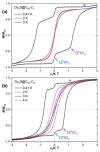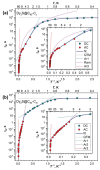Magnetic hysteresis and strong ferromagnetic coupling of sulfur-bridged Dy ions in clusterfullerene Dy2S@C82
- PMID: 33442482
- PMCID: PMC7116581
- DOI: 10.1039/D0QI00771D
Magnetic hysteresis and strong ferromagnetic coupling of sulfur-bridged Dy ions in clusterfullerene Dy2S@C82
Abstract
Two isomers of metallofullerene Dy2S@C82 with sulfur-bridged Dy ions exhibit broad magnetic hysteresis with sharp steps at sub-Kelvin temperature. Analysis of the level crossing events for different orientations of a magnetic field showed that even in powder samples, the hysteresis steps caused by quantum tunneling of magnetization can provide precise information on the strength of intramolecular Dy⋯Dy inter-actions. A comparison of different methods to determine the energy difference between ferromagnetic and antiferromagnetic states showed that sub-Kelvin hysteresis gives the most robust and reliable values. The ground state in Dy2S@C82 has ferromagnetic coupling of Dy magnetic moments, whereas the state with antiferromagnetic coupling in C s and C 3v cage isomers is 10.7 and 5.1 cm-1 higher, respectively. The value for the C s isomer is among the highest found in metallofullerenes and is considerably larger than that reported in non-fullerene dinuclear molecular magnets. Magnetization relaxation times measured in zero magnetic field at sub-Kelvin temperatures tend to level off near 900 and 3200 s in C s and C 3v isomers. These times correspond to the quantum tunneling relaxation mechanism, in which the whole magnetic moment of the Dy2S@C82 molecule flips at once as a single entity.
Conflict of interest statement
Conflicts of interest There are no conflicts to declare.
Figures





References
-
- Harriman KLM, Errulat D, Murugesu M. Magnetic Axiality: Design Principles from Molecules to Materials. Trends Chem. 2019;1:425.
- Bar AK, Kalita P, Singh MK, Rajaraman G, Chandrasekhar V. Low-coordinate mononuclear lanthanide complexes as molecular nanomagnets. Coord Chem Rev. 2018;367:163.
- Liu J-L, Chen Y-C, Tong M-L. Symmetry strategies for high performance lanthanide-based single-molecule magnets. Chem Soc Rev. 2018;47:2431. - PubMed
- Bartolomé E, Arauzo A, Luzón J, Bartolomé J, Bartolomé F. In: Handbook of Magnetic Materials. Brück E, editor. Elsevier; 2017. p. 1.
- Zhu Z, Guo M, Li X-L, Tang J. Molecular magnetism of lanthanide: Advances and perspectives. Coord Chem Rev. 2019;378:350.
- Liddle ST, van Slageren J. Improving f-element single molecule magnets. Chem Soc Rev. 2015;44:6655. - PubMed
- Zhang P, Zhang L, Tang J. Lanthanide single molecule magnets: Progress and perspective. Dalton Trans. 2015;44:3923. - PubMed
-
- Ungur L, Chibotaru LF. Ab Initio Crystal Field for Lanthanides. Chem – Eur J. 2017;23:3708. - PubMed
- Ungur L, Chibotaru LF. Strategies toward High-Temperature Lanthanide-Based Single-Molecule Magnets. Inorg Chem. 2016;55:10043. - PubMed
- Pugh T, Chilton NF, Layfield RA. A Low-Symmetry Dysprosium Metallocene Single-Molecule Magnet with a High Anisotropy Barrier. Angew Chem, Int Ed. 2016;55:11082. - PubMed
- Ding Y-S, Chilton NF, Winpenny REP, Zheng Y-Z. On Approaching the Limit of Molecular Magnetic Anisotropy: A Near-Perfect Pentagonal Bipyramidal Dysprosium(III) Single-Molecule Magnet. Angew Chem, Int Ed. 2016;55:16071. - PubMed
- Guo F-S, Day BM, Chen Y-C, Tong M-L, Mansikkamäki A, Layfield RA. Magnetic hysteresis up to 80 kelvin in a dysprosium metallocene single-molecule magnet. Science. 2018;362:1400. - PubMed
- Guo F-S, Day BM, Chen Y-C, Tong M-L, Mansikkamäki A, Layfield RA. A Dysprosium Metallocene Single-Molecule Magnet Functioning at the Axial Limit. Angew Chem, Int Ed. 2017;56:11445. - PubMed
- Chen Y-C, Liu J-L, Ungur L, Liu J, Li Q-W, Wang L-F, Ni Z-P, Chibotaru LF, Chen X-M, Tong M-L. Symmetry-Supported Magnetic Blocking at 20 K in Pentagonal Bipyramidal Dy(III) Single-Ion Magnets. J Am Chem Soc. 2016;138:2829. - PubMed
- Liu J, Chen Y-C, Liu J-L, Vieru V, Ungur L, Jia J-H, Chibotaru LF, Lan Y, Wernsdorfer W, Gao S, Chen X-M, Tong M-L. A Stable Pentagonal Bipyramidal Dy(III) Single-Ion Magnet with a Record Magnetization Reversal Barrier over 1000 K. J Am Chem Soc. 2016;138:5441. - PubMed
- Wang C, Sun R, Chen Y, Wang B-W, Wang Z-M, Gao S. Assembling High-Temperature Single-Molecule Magnets with Low-Coordinate Bis(amido) Dysprosium Unit [DyN2]+ via Cl-K-Cl Linkage. CCS Chem. 2020;2:362.
- Yu K-X, Kragskow JGC, Ding Y-S, Zhai Y-Q, Reta D, Chilton NF, Zheng Y-Z. Enhancing Magnetic Hysteresis in Single-Molecule Magnets by Ligand Functionalization. Chem. 2020;6:1777.
- Krylov DS, Liu F, Avdoshenko SM, Spree L, Weise B, Waske A, Wolter AUB, Büchner B, Popov AA. Record-high thermal barrier of the relaxation of magnetization in the nitride clusterfullerene Dy2ScN@C80 I h . Chem Commun. 2017;53:7901. - PMC - PubMed
- Bala S, Huang G-Z, Ruan Z-Y, Wu S-G, Liu Y, Wang L-F, Liu J-L, Tong M-L. A square antiprism dysprosium single-ion magnet with an energy barrier over 900 K. Chem Commun. 2019;55:9939. - PubMed
- Murrie M, Canaj A, Dey S, Regincós Martí E, Wilson C, Rajaraman G. Insight into D 6h Symmetry: Targeting Strong Axiality in Stable Dysprosium(III) Hexagonal Bipyramidal Single-Ion Magnets. Angew Chem, Int Ed. 2019;58:14146. - PMC - PubMed
- McClain KR, Gould CA, Chakarawet K, Teat S, Groshens TJ, Long JR, Harvey BG. High-temperature magnetic blocking and magneto-structural correlations in a series of dysprosium (III) metallocenium single-molecule magnets. Chem Sci. 2018;9:8492. - PMC - PubMed
-
- Lunghi A, Totti F, Sessoli R, Sanvito S. The role of anharmonic phonons in under-barrier spin relaxation of single molecule magnets. Nat Commun. 2017;8:14620. - PMC - PubMed
- Escalera-Moreno L, Baldoví JJ, Gaita-Ariño A, Coronado E. Spin states, vibrations and spin relaxation in molecular nanomagnets and spin qubits: a critical perspective. Chem Sci. 2018;9:3265. - PMC - PubMed
- Winpenny REP, Chilton NF, Giansiracusa M, Collison D, Kostopoulos A. Correlating Blocking Temperatures with Relaxation Mechanisms in Monometallic Single-Molecule Magnets with High Energy Barriers (U eff > 600 K) Chem Commun. 2019;55:7025. - PubMed
- Goodwin CAP, Ortu F, Reta D, Chilton NF, Mills DP. Molecular magnetic hysteresis at 60 kelvin in dysprosocenium. Nature. 2017;548:439. - PubMed
- Chiesa A, Cugini F, Hussain R, Macaluso E, Allodi G, Garlatti E, Giansiracusa M, Goodwin CAP, Ortu F, Reta D, Skelton JM, Guidi T, et al. Understanding magnetic relaxation in single-ion magnets with high blocking temperature. Phys Rev B. 2020;101:174402.
-
- Chow CY, Bolvin H, Campbell VE, Guillot R, Kampf JW, Wernsdorfer W, Gendron F, Autschbach J, Pecoraro VL, Mallah T. Assessing the exchange coupling in binuclear lanthanide(iii) complexes and the slow relaxation of the magnetization in the antiferromagnetically coupled Dy2 derivative. Chem Sci. 2015;6:4148. - PMC - PubMed
- Guo Y-N, Xu G-F, Wernsdorfer W, Ungur L, Guo Y, Tang J, Zhang H-J, Chibotaru LF, Powell AK. Strong Axiality and Ising Exchange Interaction Suppress Zero-Field Tunneling of Magnetization of an Asymmetric Dy2 Single-Molecule Magnet. J Am Chem Soc. 2011;133:11948. - PubMed
- Habib F, Murugesu M. Lessons learned from dinuclear lanthanide nano-magnets. Chem Soc Rev. 2013;42:3278. - PubMed
- Westerström R, Dreiser J, Piamonteze C, Muntwiler M, Weyeneth S, Krämer K, Liu S-X, Decurtins S, Popov A, Yang S, Dunsch L, Greber T. Tunneling, remanence, and frustration in dysprosium-based endohedral single-molecule magnets. Phys Rev B: Condens Matter Mater Phys. 2014;89:060406.
- Han T, Giansiracusa MJ, Li Z-H, Ding Y-S, Chilton NF, Winpenny REP, Zheng Y-Z. Exchange-Biasing in a Dinuclear Dysprosium(III) Single-Molecule Magnet with a Large Energy Barrier for Magnetisation Reversal. Chem – Eur J. 2020;26:6773. - PubMed
-
- Demir S, Jeon I-R, Long JR, Harris TD. Radical ligand-containing single-molecule magnets. Coord Chem Rev. 2015;149:289–290.
- Demir S, Gonzalez MI, Darago LE, Evans WJ, Long JR. Giant coercivity and high magnetic blocking temperatures for N2 3− radical-bridged dilanthanide complexes upon ligand dissociation. Nat Commun. 2017;8:2144. - PMC - PubMed
- Liu F, Velkos G, Krylov DS, Spree L, Zalibera M, Ray R, Samoylova NA, Chen C-H, Rosenkranz M, Schiemenz S, Ziegs F, Nenkov K, et al. Air-stable redox-active nanomagnets with lanthanide spins radical-bridged by a metal-metal bond. Nat Commun. 2019;10:571. - PMC - PubMed
Grants and funding
LinkOut - more resources
Full Text Sources
